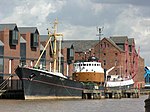Southcoates railway station
Beeching closures in EnglandDisused railway stations in Kingston upon HullFormer York and North Midland Railway stationsHull and Holderness RailwayPages with no open date in Infobox station ... and 4 more
Railway stations in Great Britain closed in 1964Railway stations in Great Britain opened in 1848Use British English from February 2017Yorkshire and the Humber railway station stubs

Southcoates railway station was a railway station on the North Eastern Railway's Victoria Dock Branch Line in Hull, East Riding of Yorkshire, England. It was opened by the York and North Midland Railway on 8 May 1848. The station was closed in November 1854 and reopened on 1 June 1864 before final closure on 19 October 1964. It served the suburb of Southcoates. Since closure the station has been completely demolished.
Excerpt from the Wikipedia article Southcoates railway station (License: CC BY-SA 3.0, Authors, Images).Southcoates railway station
Mount Pleasant, Hull Drypool
Geographical coordinates (GPS) Address Nearby Places Show on map
Geographical coordinates (GPS)
| Latitude | Longitude |
|---|---|
| N 53.751 ° | E -0.315 ° |
Address
Mount Pleasant
HU9 1NR Hull, Drypool
England, United Kingdom
Open on Google Maps









